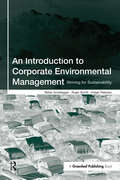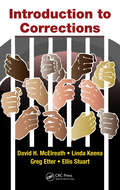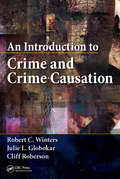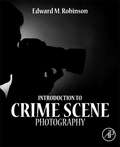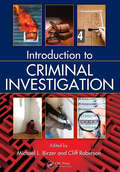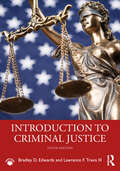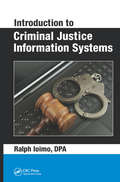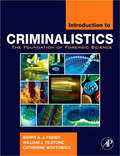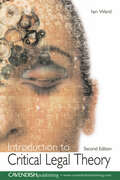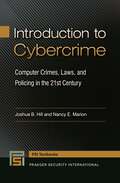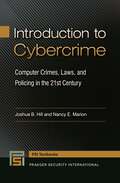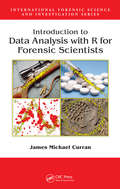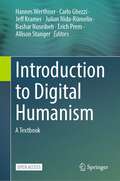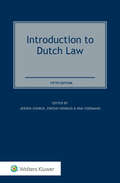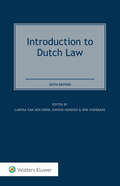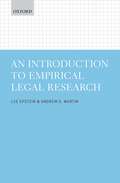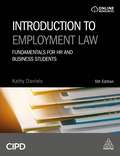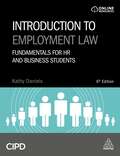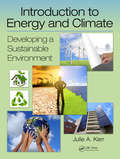- Table View
- List View
An Introduction to Corporate Environmental Management: Striving for Sustainability
by Stefan Schaltegger Roger Burritt Holger PetersenThis book is designed to meet the urgent need for a comprehensive and definitive introduction and teaching text on corporate environmental management. It aims to become the standard textbook for courses examining how business can take the environment into account while also providing an accessible and thorough overview of this increasingly multidisciplinary subject for practitioners.Written by the internationally acknowledged experts Stefan Schaltegger and Roger Burritt (authors of the highly influential Contemporary Environmental Accounting) along with Holger Petersen, the book invites the reader to join in an exploration of the ways in which companies can engage in environmental management and why such engagement can be profitable for business. The reader is invited to: examine whether the contents reflect their own experience, takes their experience further, or opposes their own views; note which of the ideas presented are especially important, add to those ideas, or encourage a reaction (positive or negative); answer questions creatively (based on their own perspective of the issues); encourage themselves to be inspired by questions, which can be investigated further through other written sources of information, such as books you will be guided to through the bibliography, the Internet or the general media; and think about and plan the ways in which the knowledge provided can be implemented in your own situation.The book is organised into four main sections. First, the fundamental ideas and linkages behind business management, the environment and sustainable development are briefly but clearly sketched. The second part of the book outlines the criteria against which environmentally oriented business management can be assessed and the fields of action in which success can be achieved. The third part presents a discussion and examples of strategies for environmental management, which are linked, in the fourth part, to the essential tools of environmental management, especially green marketing, environmental accounting and eco-control.The book is full of case studies and examples related to the main contents of each chapter and each chapter provides a number of questions for the student or reader to address.An Introduction to Corporate Environmental Management is both a textbook and a sourcebook. The reader can either work through the material in a structured way or dip into the content and follow up on specific areas of interest. The materials are designed to be used for understanding and reference, rather than to be learned by heart. The primary aim is for the reader to obtain a practical understanding of the relationship between management and environmental issues which can be applied in day-to-day situations-whether as part of a student's wider view of management or within the practitioner's real-world situation. It will be essential reading for many years to come.
An Introduction to Corporate Environmental Management: Striving for Sustainability
by Stefan Schaltegger Roger Burritt Holger PetersenThis book is designed to meet the urgent need for a comprehensive and definitive introduction and teaching text on corporate environmental management. It aims to become the standard textbook for courses examining how business can take the environment into account while also providing an accessible and thorough overview of this increasingly multidisciplinary subject for practitioners.Written by the internationally acknowledged experts Stefan Schaltegger and Roger Burritt (authors of the highly influential Contemporary Environmental Accounting) along with Holger Petersen, the book invites the reader to join in an exploration of the ways in which companies can engage in environmental management and why such engagement can be profitable for business. The reader is invited to: examine whether the contents reflect their own experience, takes their experience further, or opposes their own views; note which of the ideas presented are especially important, add to those ideas, or encourage a reaction (positive or negative); answer questions creatively (based on their own perspective of the issues); encourage themselves to be inspired by questions, which can be investigated further through other written sources of information, such as books you will be guided to through the bibliography, the Internet or the general media; and think about and plan the ways in which the knowledge provided can be implemented in your own situation.The book is organised into four main sections. First, the fundamental ideas and linkages behind business management, the environment and sustainable development are briefly but clearly sketched. The second part of the book outlines the criteria against which environmentally oriented business management can be assessed and the fields of action in which success can be achieved. The third part presents a discussion and examples of strategies for environmental management, which are linked, in the fourth part, to the essential tools of environmental management, especially green marketing, environmental accounting and eco-control.The book is full of case studies and examples related to the main contents of each chapter and each chapter provides a number of questions for the student or reader to address.An Introduction to Corporate Environmental Management is both a textbook and a sourcebook. The reader can either work through the material in a structured way or dip into the content and follow up on specific areas of interest. The materials are designed to be used for understanding and reference, rather than to be learned by heart. The primary aim is for the reader to obtain a practical understanding of the relationship between management and environmental issues which can be applied in day-to-day situations-whether as part of a student's wider view of management or within the practitioner's real-world situation. It will be essential reading for many years to come.
Introduction to Corrections
by David H. McElreathMillions in our nation are under some type of judicial sanction, with some individuals behind bars but the majority serving their sentences while living and working among us. Introduction to Corrections examines predominant issues related to the system of administering to offenders in the United States. Written in a simple, concise style and enhanc
An Introduction to Crime and Crime Causation
by Robert C. WintersAn Introduction to Crime and Crime Causation is a student-friendly textbook that defines and explains the concepts of crime, criminal law, and criminology. Ideal for a one-semester course, the book compares and contrasts early criminal behavior and today�s modern forms of crime. It also explores society�s responses to criminal behavior in the past
Introduction to Crime Scene Photography
by Edward M. RobinsonIntroduction to Crime Scene Photography acquaints the reader with the essentials of basic crime scene photography techniques. It looks at the concepts related to composition and relates them to the types of photographs captured by crime scene photographers. It explains how to capture images based on the exposure settings chosen to produce the effect desired. It considers the techniques used needed to control and maximize Depth of Field (DOF), and reviews how the different lenses will affect an image. Organized into seven chapters, the book begins with an overview of crime scene photography and composition, including the three cardinal rules of good photography. It then proceeds with a discussion of the benefits of bounce flash and how to utilize this technique to properly compose the subject of interest. It also explains how to capture any image necessary at the crime scene by combining the concepts of composition, nonflash exposure, DOF, flash exposure, and the use of various types of lenses. In addition, the reader is introduced to various energy sources and filters, digital processing of evidentiary photography, and legal issues related to photographs and digital images. Examples and illustrations are provided throughout to demonstrate how the concepts examined tend to form a sort of symbiotic relationship. This text will benefit scene investigators and photographers, forensic consultants, forensic scientists, undergraduate students in forensic and/or criminal justice programs, law enforcement professionals, and anyone who wants to acquire the skills needed to be a successful crime scene photographer. Contains over 350 high-quality 4-color imagesRules of Thumb are included to highlight key concepts
Introduction to Criminal Investigation
by Michael L. Birzer Cliff RobersonThe manner in which criminal investigators are trained is neither uniform nor consistent, ranging from sophisticated training protocols in some departments to on-the-job experience alongside senior investigators in others. Ideal for students taking a first course in the subject as well as professionals in need of a refresher, Introduction to Criminal Investigation uses an accessible format to convey concepts in practical, concrete terms.Topics discussed include: The history of criminal investigation in Western society Qualifications for becoming an investigator, the selection process, and ideal training requirements Crime scene search techniques, including planning and post-search debriefing Preparing effective field notes and investigative reports Interviewing and interrogating Types of evidence found at the crime scene and how to collect, package, and preserve it The contributions of forensic science to criminal investigations and the equipment used in crime labs Investigative protocol for a range of crimes, including property crimes, auto theft, arson, financial crimes, homicide, assault, sex crimes, and robbery Specialized investigations, including drug trafficking, cybercrime, and gang-related crime Legal issues involved in criminal investigations and preparing a case for trial Bringing together contributions from law enforcement personnel, academics, and attorneys, the book combines practical and theoretical elements to provide a comprehensive examination of today‘s criminal investigative process. The accessible manner in which the information is conveyed makes this an ideal text for a wide-ranging audience.
Introduction to Criminal Investigation
by Michael Birzer Cliff RobersonThe manner in which criminal investigators are trained is neither uniform nor consistent, ranging from sophisticated training protocols in some departments to on-the-job experience alongside senior investigators in others. Ideal for students taking a first course in the subject as well as professionals in need of a refresher, Introduction to Criminal Investigation uses an accessible format to convey concepts in practical, concrete terms.Topics discussed include: The history of criminal investigation in Western society Qualifications for becoming an investigator, the selection process, and ideal training requirements Crime scene search techniques, including planning and post-search debriefing Preparing effective field notes and investigative reports Interviewing and interrogating Types of evidence found at the crime scene and how to collect, package, and preserve it The contributions of forensic science to criminal investigations and the equipment used in crime labs Investigative protocol for a range of crimes, including property crimes, auto theft, arson, financial crimes, homicide, assault, sex crimes, and robbery Specialized investigations, including drug trafficking, cybercrime, and gang-related crime Legal issues involved in criminal investigations and preparing a case for trial Bringing together contributions from law enforcement personnel, academics, and attorneys, the book combines practical and theoretical elements to provide a comprehensive examination of today‘s criminal investigative process. The accessible manner in which the information is conveyed makes this an ideal text for a wide-ranging audience.
Introduction to Criminal Justice
by Bradley D. Edwards Lawrence F. Travis IIIIntroduction to Criminal Justice, Tenth Edition, offers a student-friendly description of the criminal justice process—outlining the decisions, practices, people, and issues involved. It provides a solid introduction to the mechanisms of the criminal justice system, with balanced coverage of the issues presented by each facet of the process, including a thorough review of practices and controversies in law enforcement, the criminal courts, and corrections.In this revision, Edwards updates the statistics and research findings throughout. New sections include the impact of the COVID-19 pandemic, the recent shift to NIBRS crime reporting, and the increasing attacks on the legitimacy of the criminal justice system. This edition has also expanded coverage of police use of force and technological improvements. Selected chapters now include a case study box to demonstrate how certain laws, programs, and technologies have been used in particular situations.Appropriate for all U.S. criminal justice programs, this text offers great value for students and instructors.
Introduction to Criminal Justice
by Bradley D. Edwards Lawrence F. Travis IIIIntroduction to Criminal Justice, Tenth Edition, offers a student-friendly description of the criminal justice process—outlining the decisions, practices, people, and issues involved. It provides a solid introduction to the mechanisms of the criminal justice system, with balanced coverage of the issues presented by each facet of the process, including a thorough review of practices and controversies in law enforcement, the criminal courts, and corrections.In this revision, Edwards updates the statistics and research findings throughout. New sections include the impact of the COVID-19 pandemic, the recent shift to NIBRS crime reporting, and the increasing attacks on the legitimacy of the criminal justice system. This edition has also expanded coverage of police use of force and technological improvements. Selected chapters now include a case study box to demonstrate how certain laws, programs, and technologies have been used in particular situations.Appropriate for all U.S. criminal justice programs, this text offers great value for students and instructors.
Introduction to Criminal Justice Information Systems
by Ralph IoimoThe proliferation of information systems throughout the criminal justice system has prompted many universities supporting criminal justice programs to add criminal justice information systems technology to their curriculums. Several universities have gone so far as to hire professors with specializations in information technology and to offer criminal justice information systems as an area of concentration. Introduction to Criminal Justice Information Systems gives an overview of the various software systems and technologies currently used in the criminal justice environment. The book covers a variety of topics critical to each member of the criminal justice system: police, prosecutor, courts, and corrections. It details the current systems in use, how they are used, and how separate systems interact with others. It also suggests how the current technology and the processes built upon it will evolve. While designed as a textbook to meet the needs of an introductory criminal justice information technology course, Introduction to Criminal Justice Information Systems is also a flexible resource useful to professionals in relevant areas of the criminal justice system. With rapidly increasing development and use of technology in modern law enforcement, this book provides a much-needed reference for those who are responsible for its implementation as well as an essential introduction to those who will become responsible for it. An instructor's manual is available as an electronic download upon request.
Introduction to Criminal Justice Information Systems
by Ralph IoimoThe proliferation of information systems throughout the criminal justice system has prompted many universities supporting criminal justice programs to add criminal justice information systems technology to their curriculums. Several universities have gone so far as to hire professors with specializations in information technology and to offer criminal justice information systems as an area of concentration. Introduction to Criminal Justice Information Systems gives an overview of the various software systems and technologies currently used in the criminal justice environment. The book covers a variety of topics critical to each member of the criminal justice system: police, prosecutor, courts, and corrections. It details the current systems in use, how they are used, and how separate systems interact with others. It also suggests how the current technology and the processes built upon it will evolve. While designed as a textbook to meet the needs of an introductory criminal justice information technology course, Introduction to Criminal Justice Information Systems is also a flexible resource useful to professionals in relevant areas of the criminal justice system. With rapidly increasing development and use of technology in modern law enforcement, this book provides a much-needed reference for those who are responsible for its implementation as well as an essential introduction to those who will become responsible for it. An instructor's manual is available as an electronic download upon request.
Introduction to Criminalistics: The Foundation of Forensic Science
by William J. Tilstone Barry A.J. Fisher Catherine WoytowiczIntroduction to Criminalistics covers the basics of Criminalistics in a textbook for a one or two semester course, with the intention of preparing the student for a future in forensic science. The role of the Criminalist is to analyze, compare, identify, and interpret physical evidence in the crime lab. These crime labs, or forensic labs, have two primary functions: identifying evidence and linking the suspect, victim, and crime scene through physical evidence. This new primer introduces the learner to the structure and organization of the crime lab and to the role of the Criminalist. It features real cases – recent and historic – to illustrate concepts. Colorful pedagogy clearly defines chapter elements and sets this text apart from next best. Topics covered include how to process a crime scene and preserve evidence, the basic principles of firearm examination, latent fingerprints, and rudimentary toxicology, or how to determine the presence or absence of drugs and poisons. Well organized and methodical, this textbook has the potential to become the standard text for applying techniques of the physical and natural sciences to examining physical evidence. Uses real cases – recent and historic – to illustrate conceptsColorful pedagogy clearly defines chapter elements and sets this text apart from next bestPresents the basics of forensic sciences in a one-semester or one-year courseOffers excellent preparation for professional examinationsDelivers the latest in laboratory technique while acknowledging the limits of technology
Introduction to Critical Legal Theory
by Ian WardIntroduction to Critical Legal Theory provides an accessible introduction to the study of law and legal theory. It covers all the seminal movements in classical, modern and postmodern legal thought, engaging the reader with the ideas of jurists as diverse as Aristotle, Hobbes and Kant, Marx, Foucault and Dworkin. At the same time, it impresses the interdisciplinary nature of critical legal thought, introducing the reader to the philosophy, the economics and the politics of law. This new edition focuses even more intently upon the narrative aspect of critical legal thinking and the re-emergence of a distinctive legal humanism, as well as the various related challenges posed by our 'new' world order. Introduction to Critical Theory is a comprehensive text for both students and teachers of legal theory, jurisprudence and related subjects.
Introduction to Critical Legal Theory
by Ian WardIntroduction to Critical Legal Theory provides an accessible introduction to the study of law and legal theory. It covers all the seminal movements in classical, modern and postmodern legal thought, engaging the reader with the ideas of jurists as diverse as Aristotle, Hobbes and Kant, Marx, Foucault and Dworkin. At the same time, it impresses the interdisciplinary nature of critical legal thought, introducing the reader to the philosophy, the economics and the politics of law. This new edition focuses even more intently upon the narrative aspect of critical legal thinking and the re-emergence of a distinctive legal humanism, as well as the various related challenges posed by our 'new' world order. Introduction to Critical Theory is a comprehensive text for both students and teachers of legal theory, jurisprudence and related subjects.
Introduction to Cybercrime: Computer Crimes, Laws, and Policing in the 21st Century (Praeger Security International Textbook)
by Joshua B. Hill Nancy E. MarionExplaining cybercrime in a highly networked world, this book provides a comprehensive yet accessible summary of the history, modern developments, and efforts to combat cybercrime in various forms at all levels of government—international, national, state, and local.As the exponential growth of the Internet has made the exchange and storage of information quick and inexpensive, the incidence of cyber-enabled criminal activity—from copyright infringement to phishing to online pornography—has also exploded. These crimes, both old and new, are posing challenges for law enforcement and legislators alike. What efforts—if any—could deter cybercrime in the highly networked and extremely fast-moving modern world? Introduction to Cybercrime: Computer Crimes, Laws, and Policing in the 21st Century seeks to address this tough question and enables readers to better contextualize the place of cybercrime in the current landscape.This textbook documents how a significant side effect of the positive growth of technology has been a proliferation of computer-facilitated crime, explaining how computers have become the preferred tools used to commit crimes, both domestically and internationally, and have the potential to seriously harm people and property alike. The chapters discuss different types of cybercrimes—including new offenses unique to the Internet—and their widespread impacts. Readers will learn about the governmental responses worldwide that attempt to alleviate or prevent cybercrimes and gain a solid understanding of the issues surrounding cybercrime in today's society as well as the long- and short-term impacts of cybercrime.
Introduction to Cybercrime: Computer Crimes, Laws, and Policing in the 21st Century (Praeger Security International Textbook)
by Joshua B. Hill Nancy E. MarionExplaining cybercrime in a highly networked world, this book provides a comprehensive yet accessible summary of the history, modern developments, and efforts to combat cybercrime in various forms at all levels of government—international, national, state, and local.As the exponential growth of the Internet has made the exchange and storage of information quick and inexpensive, the incidence of cyber-enabled criminal activity—from copyright infringement to phishing to online pornography—has also exploded. These crimes, both old and new, are posing challenges for law enforcement and legislators alike. What efforts—if any—could deter cybercrime in the highly networked and extremely fast-moving modern world? Introduction to Cybercrime: Computer Crimes, Laws, and Policing in the 21st Century seeks to address this tough question and enables readers to better contextualize the place of cybercrime in the current landscape.This textbook documents how a significant side effect of the positive growth of technology has been a proliferation of computer-facilitated crime, explaining how computers have become the preferred tools used to commit crimes, both domestically and internationally, and have the potential to seriously harm people and property alike. The chapters discuss different types of cybercrimes—including new offenses unique to the Internet—and their widespread impacts. Readers will learn about the governmental responses worldwide that attempt to alleviate or prevent cybercrimes and gain a solid understanding of the issues surrounding cybercrime in today's society as well as the long- and short-term impacts of cybercrime.
Introduction to Data Analysis with R for Forensic Scientists
by James Michael CurranStatistical methods provide a logical, coherent framework in which data from experimental science can be analyzed. However, many researchers lack the statistical skills or resources that would allow them to explore their data to its full potential. Introduction to Data Analysis with R for Forensic Sciences minimizes theory and mathematics and focus
Introduction to Digital Humanism: A Textbook
by Hannes Werthner Carlo Ghezzi Jeff Kramer Julian Nida-Rümelin Bashar Nuseibeh Erich Prem Allison StangerThis open access textbook introduces and defines digital humanism from a diverse range of disciplines. Following the 2019 Vienna Manifesto, the book calls for a digital humanism that describes, analyzes, and, most importantly, influences the complex interplay of technology and humankind, for a better society and life, fully respecting universal human rights. The book is organized in three parts: Part I “Background” provides the multidisciplinary background needed to understand digital humanism in its philosophical, cultural, technological, historical, social, and economic dimensions. The goal is to present the necessary knowledge upon which an effective interdisciplinary discourse on digital humanism can be founded. Part II “Digital Humanism – a System’s View” focuses on an in-depth presentation and discussion of the main digital humanism concerns arising in current digital systems. The goal of this part is to make readers aware and sensitive to these issues, including e.g. the control and autonomy of AI systems, privacy and security, and the role of governance. Part III “Critical and Societal Issues of Digital Systems” delves into critical societal issues raised by advances of digital technologies. While the public debate in the past has often focused on them separately, especially when they became visible through sensational events the aim here is to shed light on the entire landscape and show their interconnected relationships. This includes issues such as AI and ethics, fairness and bias, privacy and surveillance, platform power and democracy. This textbook is intended for students, teachers, and policy makers interested in digital humanism. It is designed for stand-alone and for complementary courses in computer science, or curricula in science, engineering, humanities and social sciences. Each chapter includes questions for students and an annotated reading list to dive deeper into the associated chapter material. The book aims to provide readers with as wide an exposure as possible to digital advances and their consequences for humanity. It includes constructive ideas and approaches that seek to ensure that our collective digital future is determined through human agency.
Introduction to Dutch Law
by Jeroen Chorus Ewoud Hondius Wim VoermansA standard legal resource since its first edition in 1978, this matchless book has proven itself the ideal overview of Dutch law for foreign lawyers. This Fifth Edition fully updates its systematic description of the legal sources, institutions, and concepts in all major fields of law. Recent developments covered include the progressive implementation of standards set by international conventions, the reorganization of the judiciary, the statute on environmental law, and the (re)codification of private international law. The continuing influence of European law is evident in many fields, perhaps most notably in family law. The various chapters are written by experts – scholars and lawyers – in particular fields, and provide an authoritative overview of each field. The historical sources of Dutch law are discussed, as well as Dutch legal culture, judicial organization, legal education, and the legal profession. These chapters are followed by introductions to essential issues of private and public law and labour law. The last chapter examines questions of legal philosophy. The only resource of its kind available, this book is unmatched as a thorough guide to further research. It offers practitioners, particularly foreign lawyers, a quick and reliable way into any area of Dutch law that they may be required to research. It will also be of great value to comparatists (especially those studying the influence of European law on national legal systems), scholars, and students. Like previous editions, the Fifth Edition has been prepared under the auspices of the Netherlands Comparative Law Association.
Introduction to Dutch Law
A standard legal resource since its first edition in 1978, this matchless book has proven itself the ideal overview of Dutch law for foreign lawyers. This Sixth Edition fully updates its systematic description of the legal sources, institutions, and concepts in all major fields of law. Recent developments covered include the progressive implementation of standards set by international conventions, the reorganization of the judiciary, the statute on environmental law, and the (re)codification of private international law. The continuing influence of European law is evident in many fields, perhaps most notably in family law. The various chapters are written by experts – scholars and lawyers – in particular fields, and provide an authoritative overview of each field. The historical sources of Dutch law are discussed, as well as Dutch legal culture, legal philosophy, judicial organization, legal education, and the legal profession. These chapters are followed by introductions to essential issues of private and public law and labour law. The last chapter examines financial law. The only resource of its kind available, this book is unmatched as a thorough guide to further research. It offers practitioners, particularly foreign lawyers, a quick and reliable way into any area of Dutch law that they may be required to research. It will also be of great value to comparatists (especially those studying the influence of European law on national legal systems), scholars, and students. Like previous editions, the Sixth Edition has been prepared under the auspices of the Netherlands Comparative Law Association.
An Introduction to Empirical Legal Research
by Lee Epstein Andrew D. MartinIs the death penalty a more effective deterrent than lengthy prison sentences? Does a judge's gender influence their decisions? Do independent judiciaries promote economic freedom? Answering such questions requires empirical evidence, and arguments based on empirical research have become an everyday part of legal practice, scholarship, and teaching. In litigation judges are confronted with empirical evidence in cases ranging from bankruptcy and taxation to criminal law and environmental infringement. In academia researchers are increasingly turning to sophisticated empirical methods to assess and challenge fundamental assumptions about the law. As empirical methods impact on traditional legal scholarship and practice, new forms of education are needed for today's lawyers. All lawyers asked to present or assess empirical arguments need to understand the fundamental principles of social science methodology that underpin sound empirical research. An Introduction to Empirical Legal Research introduces that methodology in a legal context, explaining how empirical analysis can inform legal arguments; how lawyers can set about framing empirical questions, conducting empirical research, analysing data, and presenting or evaluating the results. The fundamentals of understanding quantitative and qualitative data, statistical models, and the structure of empirical arguments are explained in a way accessible to lawyers with or without formal training in statistics. Written by two of the world's leading experts in empirical legal analysis, drawing on years of experience in training lawyers in empirical methods, An Introduction to Empirical Legal Research will be an invaluable primer for all students, academics, or practising lawyers coming to empirical research - whether they are embarking themselves on an empirical research project, or engaging with empirical arguments in their field of study, research, or practice.
An Introduction to Empirical Legal Research
by Lee Epstein Andrew D. MartinIs the death penalty a more effective deterrent than lengthy prison sentences? Does a judge's gender influence their decisions? Do independent judiciaries promote economic freedom? Answering such questions requires empirical evidence, and arguments based on empirical research have become an everyday part of legal practice, scholarship, and teaching. In litigation judges are confronted with empirical evidence in cases ranging from bankruptcy and taxation to criminal law and environmental infringement. In academia researchers are increasingly turning to sophisticated empirical methods to assess and challenge fundamental assumptions about the law. As empirical methods impact on traditional legal scholarship and practice, new forms of education are needed for today's lawyers. All lawyers asked to present or assess empirical arguments need to understand the fundamental principles of social science methodology that underpin sound empirical research. An Introduction to Empirical Legal Research introduces that methodology in a legal context, explaining how empirical analysis can inform legal arguments; how lawyers can set about framing empirical questions, conducting empirical research, analysing data, and presenting or evaluating the results. The fundamentals of understanding quantitative and qualitative data, statistical models, and the structure of empirical arguments are explained in a way accessible to lawyers with or without formal training in statistics. Written by two of the world's leading experts in empirical legal analysis, drawing on years of experience in training lawyers in empirical methods, An Introduction to Empirical Legal Research will be an invaluable primer for all students, academics, or practising lawyers coming to empirical research - whether they are embarking themselves on an empirical research project, or engaging with empirical arguments in their field of study, research, or practice.
Introduction to Employment Law: Fundamentals for HR and Business Students
by Kathy DanielsWritten specifically for HR and Business students, Introduction to Employment Law is a clear and accessible guide to employment law and how it applies in practice. Covering everything from employment tribunals and discrimination to redundancy and termination of employment, this textbook doesn't assume any prior knowledge of the UK legal system and equips students with all the knowledge and skills that they need to take forward into the workplace.Fully revised with all the latest cases and legal developments, this new edition includes coverage of hot topics such as defining employment status in the gig economy, gender pay reporting, the General Data Protection Regulation (GDPR) and the legal implications to be considered with Britain's withdrawal from the European Union. Packed with pedagogical features to consolidate learning including chapter objectives, tasks, 'explore further' sections, key learning points and examples to work through, as well as a dedicated study skills chapter, Introduction to Employment Law is essential reading for all students studying the CIPD Level 5 Intermediate module in employment law as well as being a useful resource for those studying at level 3 and an accessible introduction for level 7 and those on undergraduate and postgraduate courses needing a thorough grounding in employment law. Online resources include lecture slides, case studies, multiple choice questions, annotated weblinks and an instructor's manual.
Introduction to Employment Law: Fundamentals for HR and Business Students
by Kathy DanielsWritten specifically for HR and business students, Introduction to Employment Law is a clear, accessible and jargon-free guide to UK employment law and how it applies in practice. This book covers all the essentials of employment law including employment contracts, discrimination, redundancy and employment tribunals. There is also expert guidance on key issues including shared parental leave, flexible working policies and protected characteristics. Fully revised with the latest cases and legal developments, this new edition includes coverage of the rights of agency workers, bereavement leave, furlough practices and the legal implications of Brexit. This textbook doesn't assume any prior knowledge of the UK legal system and equips students with the knowledge and skills that they need to take forward into the workplace. Packed with pedagogical features to consolidate learning including tasks, examples, explore further sections and key learning points as well as a dedicated study skills chapter covering employment law assignments and exams, Introduction to Employment Law is essential reading for all students studying the CIPD Level 5 Intermediate module in employment law. It is also an accessible introduction for Level 7 students and those on undergraduate and postgraduate business courses needing a thorough grounding in employment law. Online resources include lecture slides, case studies, annotated weblinks and an instructor's manual.
Introduction to Energy and Climate: Developing a Sustainable Environment
by Julie KerrThe purpose of this textbook is to provide a well-rounded working knowledge of both climate change and environmental sustainability for a wide range of students. Students will learn core concepts and methods to analyze energy and environmental impacts; will understand what is changing the earth’s climate, and what that means for life on earth now and in the future. They will also have a firm understanding of what energy is and how it can be used. This text intends to develop working knowledge of these topics, with both technical and social implications. Students will find in one volume the integration and careful treatment of climate, energy, and sustainability.
